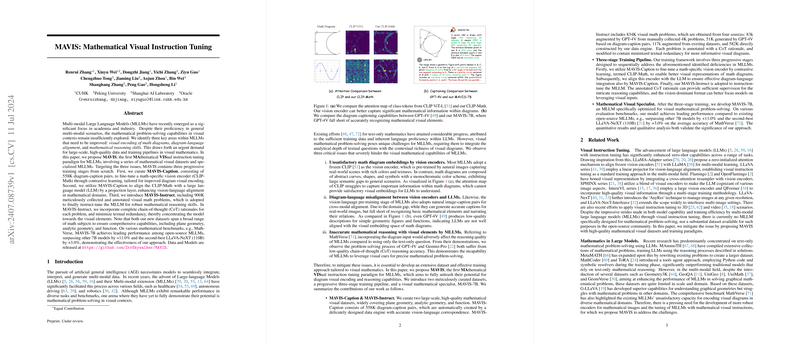MAVIS: Mathematical Visual Instruction Tuning
The paper "MAVIS: Mathematical Visual Instruction Tuning" introduces an innovative approach in advancing Multi-modal LLMs (MLLMs) to enhance their visual mathematical problem-solving capabilities. Despite the impressive performance of MLLMs across various domains, their proficiency in interpreting and reasoning within visual mathematical contexts has been notably inadequate. This work aims to address these deficiencies by proposing MAVIS, a comprehensive training paradigm specifically designed for improving MLLMs in visual mathematical scenarios.
Key Contributions
The authors identify three critical areas that hinder the current effectiveness of MLLMs in visual mathematics: visual encoding of mathematical diagrams, alignment of diagrams with language, and accurate mathematical reasoning. To address these, the MAVIS framework incorporates three progressive training stages and introduces significant contributions, providing both new datasets and a robust training pipeline.
- Datasets:
- MAVIS-Caption: This dataset includes 588K diagram-caption pairs focused on diverse mathematical topics such as plane geometry, analytic geometry, and functions. The dataset is curated to enhance the visual encoding capabilities of MLLMs through a math-specific vision encoder.
- MAVIS-Instruct: Comprising 834K visual math problems, this dataset provides structured problems with annotated CoT rationales, aimed at refining reasoning skills. It draws from various sources and reduces textual redundancy to emphasize visual elements, covering broad mathematical domains.
- Training Stages:
- Stage 1: CLIP-Math Encoder: The initial stage involves fine-tuning a vision encoder using MAVIS-Caption with contrastive learning, specifically aimed at improving the visual representation of mathematical diagrams.
- Stage 2: Diagram-Language Alignment: This stage aligns the enhanced vision encoder with a LLM by employing a projection layer, further utilizing MAVIS-Caption to refine language and diagram integration.
- Stage 3: Instruction Tuning: Finally, MAVIS-Instruct is used to fine-tune MLLMs for CoT reasoning, significantly enhancing problem-solving capabilities in visual mathematical contexts.
Experimental Results
The MAVIS framework demonstrates substantial improvements in mathematical benchmarks. Notably, MAVIS-7B surpasses other open-source models by margins of +11.0% against similar 7B models and +3.0% over the second-best LLaVA-NeXT (110B). These results underscore MAVIS's efficacy in improving diagram interpretation and reasoning accuracy within MLLMs. The performance on benchmarks like MathVerse and specific datasets like GeoQA further validates MAVIS-7B's robustness in addressing visual mathematical challenges.
Theoretical and Practical Implications
The approach outlined in MAVIS provides a profound contribution to the field of AI by illustrating a method for significantly enhancing the mathematical reasoning capabilities of MLLMs in visual contexts. By creating specialized datasets and a multi-stage training procedure, the paper advances both the theoretical understanding and the practical capabilities of MLLMs. These advancements hold promise for various applications, including education, automated tutoring, and any domain where visual mathematical reasoning is essential.
Future Directions
The MAVIS framework opens avenues for future research, particularly in optimizing the training techniques for further scalability and applying similar methodologies to other domains requiring multimodal reasoning. Exploration into more generalized training frameworks that can be adapted to different subject matters could yield broader enhancements to the capabilities of MLLMs across disciplines.
In summary, this paper presents MAVIS as a structured and comprehensive approach to addressing the critical gap in visual mathematical reasoning within MLLMs, laying the groundwork for future exploration and application in the field of AI.
